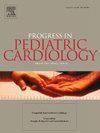法尤姆地区新生儿先天性心脏病患病率
IF 0.8
Q4 PEDIATRICS
引用次数: 0
摘要
先天性心脏病(CHD)是一种严重的心脏腔室或主要血管结构异常,影响其功能。目的了解埃及法尤姆地区新生儿冠心病的发生情况。方法本横断面观察研究纳入2247例活产婴儿。研究对象是从2018年1月至2019年12月期间在法尤姆大学医院、法尤姆保险医院和其他五家综合医院出生的新生儿中选择的。结果2192例(97.6%)新生儿无先天性心脏缺陷,55例(2.4%)新生儿诊断为冠心病。19例(34.5%)冠心病患者有亲本血缘关系。无肺型冠心病患者中:室间隔缺损13例(23.6%),动脉导管未闭7例(12.7%),房间隔缺损6例(10.9%),肺动脉狭窄5例(9.1%),主动脉狭窄2例(3.6%),房室管缺损2例(3.6%),主动脉缩窄1例(1.8%),外周肺动脉狭窄1例(1.8%)。紫绀型冠心病7例(12.7%)为法洛四联症,4例(7.3%)为肺动脉闭锁,3例(5.5%)为大动脉转位,1例(1.8%)为复杂冠心病、单心室、肺静脉全异常回流、三尖瓣闭锁。结论该研究表明,法尤姆地区出生时冠心病患病率与全球估计值一致。无氰型冠心病,尤其是室间隔缺损,是最常见的心脏异常。本文章由计算机程序翻译,如有差异,请以英文原文为准。
Prevalence of congenital heart disease among neonates in Fayoum district
Background
Congenital heart disease (CHD) is a significant structural irregularity in the heart's chambers or major vessels, affecting its function.
Objectives
To determine the occurrence of CHD among newborns in the Fayoum district of Egypt.
Methods
This cross-sectional observational study included 2247 live births. Subjects were selected over a two-year period from neonates born at Fayoum University Hospital, Fayoum Insurance Hospital, and five other general hospitals between January 2018 and December 2019.
Results
Among the studied sample, 2192 newborns (97.6 %) had no congenital heart defect, while 55 (2.4 %) were diagnosed with CHD. Parental consanguinity was reported in 19 cases (34.5 %) with CHD. Among the acyanotic CHD cases: 13 (23.6 %) had ventricular septal defect, 7 (12.7 %) had patent ductus arteriosus, 6 (10.9 %) had atrial septal defect, 5 (9.1 %) had pulmonary stenosis, 2 (3.6 %) had aortic stenosis, 2 (3.6 %) had atrioventricular canal defect, 1 (1.8 %) had coarctation of the aorta, and 1 (1.8 %) had peripheral pulmonary stenosis. Regarding cyanotic CHD, 7 patients (12.7 %) had tetralogy of Fallot, 4 (7.3 %) had pulmonary atresia, 3 (5.5 %) had transposition of the great arteries, and one patient (1.8 %) each had complex CHD, single ventricle, total anomalous pulmonary venous return, and tricuspid atresia.
Conclusion
The study reveals that the birth prevalence of CHD in the Fayoum district is consistent with global estimates. Acyanotic CHD, particularly ventricular septal defect, was the most commonly observed cardiac anomaly.
求助全文
通过发布文献求助,成功后即可免费获取论文全文。
去求助
来源期刊

PROGRESS IN PEDIATRIC CARDIOLOGY
PEDIATRICS-
CiteScore
0.90
自引率
11.10%
发文量
69
审稿时长
75 days
期刊介绍:
Progress in Pediatric Cardiology is an international journal of review presenting information and experienced opinion of importance in the understanding and management of cardiovascular diseases in children. Each issue is prepared by one or more Guest Editors and reviews a single subject, allowing for comprehensive presentations of complex, multifaceted or rapidly changing topics of clinical and investigative interest.
 求助内容:
求助内容: 应助结果提醒方式:
应助结果提醒方式:


